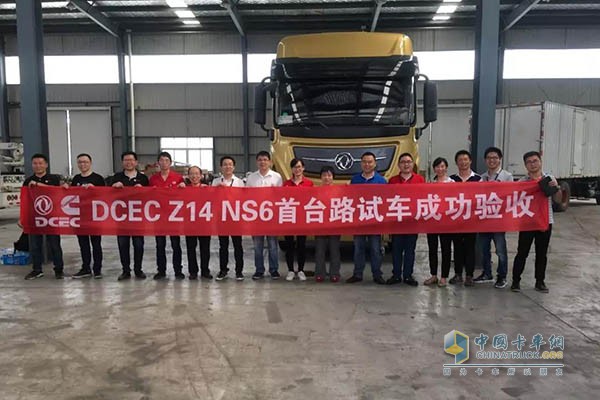 Z14 road test acceptance team
Z14 road test acceptance team
In the test, the Z14 engine was matched with the Tianlong flagship tractor . In the first half of 2018, the Tianlong flagship equipped with the ISZ13L engine achieved good sales performance and established a good reputation in the market for power and fuel consumption performance. This made the project team's staff intimately use the Guoliu Z14 engine. It is called "Dragon King". After all-round development work with the vehicle in design, performance, and electronic control, the first batch of road test vehicles loaded with “Tianlongxin†completed the acceptance work in July 2018 and officially started running.
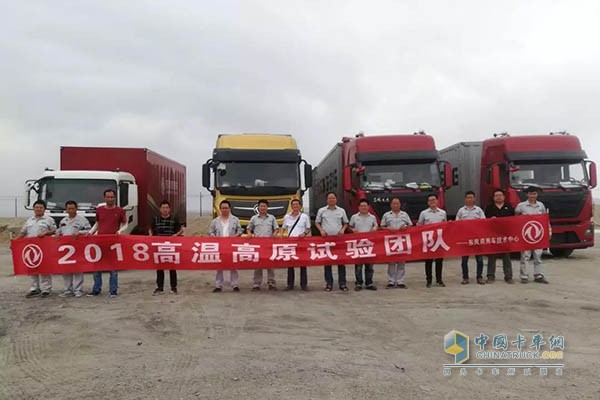 Team member taking a group photo
Team member taking a group photo
The "three high test" includes three projects of high temperature, high altitude and high cold. High temperature refers to the summer calibration test. The engine is debugged under high temperature conditions (above 40 degrees Celsius) to meet the requirements of the national six emission, but also to consider the fuel consumption and power performance, and improve the adaptability of the vehicle in high temperature environment. Operational. At the same time, the status of the use limit of engine parts in high temperature environment is monitored, which provides basic data for further optimization. This is an essential part of the engine development process to ensure that the car will not open in the hot summer. And the occurrence of problems such as fire, let consumers use it with confidence.
 Xinjiang Turpan high temperature test site
Xinjiang Turpan high temperature test site
The high temperature test site of Dongfeng Cummins Guoliu Z14 engine is the famous "Flame Mountain"---Turpan, Xinjiang. The ambient temperature in summer can reach 40~45°C, and the surface temperature can reach above 60°C. On July 15, 2018, on August 10, 2018, the test vehicle had completed a one-month high temperature test in Turpan, Xinjiang. Through this test, the technicians have a large amount of detailed and valuable data, and the entire team is very satisfied with the test process and results.
After the high temperature test, the batch of test vehicles went directly to the Qinghai-Tibet Plateau and began a plateau test in Golmud. The test is to debug the engine at high altitude (above 4000 meters above sea level) to improve the performance of the engine plateau, so that the vehicle can maintain good power and economy at high altitude. The plateau test of the National Sixth Z14 engine will last for one to two months.
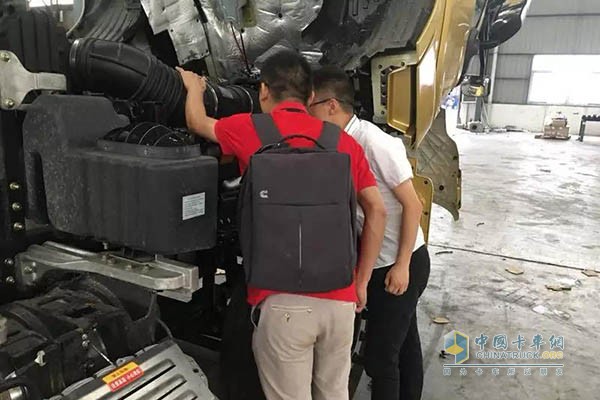 Product/service engineer is troubleshooting
Product/service engineer is troubleshooting
It is expected that the alpine test of the Guoliu Z14 engine will also start at the end of the year, and the winter calibration test needs to debug the engine under low temperature conditions (below 30 degrees Celsius). The main test contents include low temperature startability, low temperature driving, idle speed stability, icing test, and fault diagnosis. At that time, Kangkang will have follow-up reports.
It is recognized in the industry that Dongfeng Cummins has a strong ability in the design of basic machines and power cylinders. At the same time, it continues the technical heritage of Cummins for 100 years, with updated and more complete design, development and verification workflows. Based on this, Dongfeng Cummins' new generation of heavy-duty engine Z14, which meets the national six/Euro six emission standards, can fully meet the core competitiveness of high durability, reliability, economy, power and light weight. It has set a new benchmark for the industry.
Reading volume: Source: Cummins DCEC Author: Zebian
Now every country optimistic about the prospect of the magnesium alloy die castings,especially in auto,aviation,telecom,transportation and mechanical industry,
which adopt to use magnesium alloy die casting to replace steel casting for reducing weight effectively and then can save energy and reduce environment pollution. The car can decrease 0.4L oil consumption per kilometer if it can relieve every 100KGS. So America,Japan and European countries have enlarge use of magnesium alloy Die Casting Parts, for example, steering wheel, instrument panel, seat skeleton, crankcase, gearbox shell, wheel hub and so on. So magnesium alloy die castings grows at 20%~30% a year, 80% of them are die casting parts. Meanwhile magnesium alloy die castings expand use in appliance light industry and daily hardware, such as notebook shell, VCR box, mobile phone, power tool shell,camera shell, upholstery, mower shell etc. These magnesium alloy die casting parts with a series of advantages, not only greatly reduce weight, but also have the precise & steady dimension and smooth finish surface.
Die-cast magnesium alloy material:
Magnesium and aluminum have big differences in the chemical, physical properties, mainly in terms of chemical reactivity, surface oxidation of the liquid metal
material tightness, thermal effects during solidification, resistant to electricity chemical corrosion resistance capabilities.
Magnesium has a strong chemical reactivity than aluminum and the metal bath surface can not be formed as dense as molten aluminum alloy oxide protective film
to prevent oxidation reaction to proceed, so magnesium alloy flammable or explosive. Magnesium alloy is also easy to dissolve other metals, including magnesium
alloy severely reduce the ability of anti-electrochemical corrosion of nickel, copper and other elements. In addition, the same volume of liquid aluminum and magnesium alloy during solidification.
Magnesium alloy heat release was significantly lower than aluminum.
Magnesium alloy chemical elements:
Mechanical properties of pure magnesium is very poor, can not meet the requirements of industrial parts of the yield strength and tensile strength. By adding alloying elements can significantly improve the mechanical properties of magnesium, the magnesium alloy`s strength to weight than the titanium alloy in all kinds of alloying and ranked second, open up broad prospects for its application.
The effect of alloying element second is to improve the performance of magnesium alloy casting. Pure magnesium have high melting point, poor mobility, high shrinkage.
By alloying can reduce the temperature of the liquid, increase liquidity. According to the characteristics of magnesium alloy decreased significantly at temperature above 150degrees Celsius and the strength of the alloy,
the third role is to enhance the creep resistance of magnesium alloy.
Magnesium alloy commonly used alloying elements are aluminum and zinc. Alloying of aluminum alloy can improve the strength and casting properties. Zinc can also improve the performance of the alloy casting. In order to ensure the casting performance, the aluminum content should be more than 3% in the die casting magnesium alloy, zinc content is less than 2%. Otherwise it is easy to produce crack.
The commonly used magnesium alloy die-casting material

Common cold chamber die casting machine injection parts must be improved to meet the needs of the magnesium alloy die casting production as follows:
1) Fast injection speed increased from 4~5m/s to 6~10m/s.
2) Reduce the time of supercharging and build pressure.
3) Improve the injection speed and injection force control.
4) Equipped with a special furnace protection gas device
The aluminum die casting part production flow chart
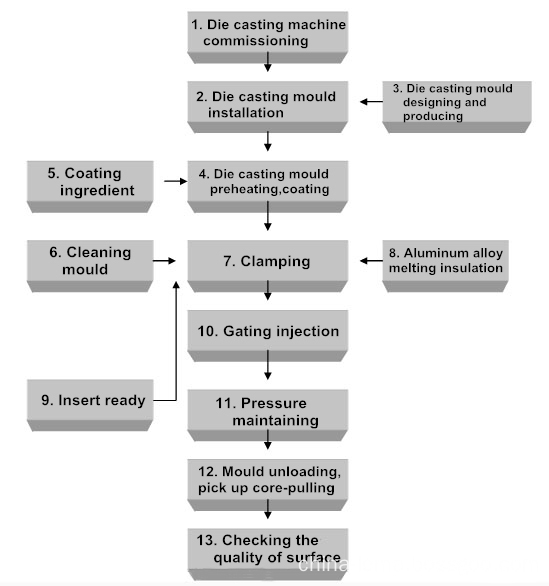
Commonly used materials of magnesium alloy die casting: ADC12, ZL101, ZL102,A380, AlSi9Cu3, AlSi12(Fe);
The precision of the magnesium die casting: ±0.1mm;
Smoothness of surface of rough part: Ra1.6~Ra3.2;
Shrinkage rate of Mg alloy die casting products: 0.5%;
Material wastage rate: 5%;
General magnesium die-casting machining allowance: 0.5mm~0.7mm;
Surface preparation methods: Sand blasted, Shot blasting, Powder coating, Painting, Plating, Electrophoresis, Polishing
Our company's magnesium alloy die casting production equipment and management system
Aluminum Die casting production equipment: L.K brand die casting machine From 160T, 200T, 280T, 400T, 630T, 800T and 1250T;
CNC machining center: 8 sets;
CNC lathe machine: 6 Guangzhou Machines and 7 Shenyang Machines;
Work days of one week: From Monday to Saturday;
Shift work: 2 shift per day;
Working hours: From AM 8:00 to PM 5:00;
2D and 3D drawing Software: AutoCAD, UG, Pro/E, SolidWorks 2013;
QC control: New type NANO CMM, FPI M5000 desktop metal analyzer, Easson projector, Mechanical properties tester.
The production of Magnesium die casting and QC control
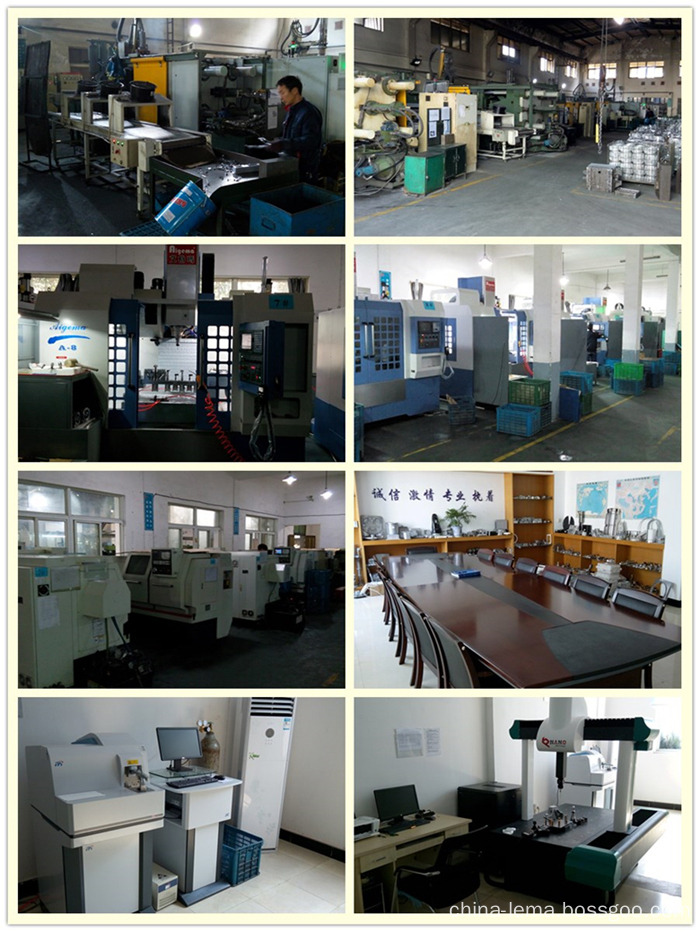
Magnesium Die Casting Part, Magnesium Alloy Die Casting Part, Magnesium Die-Casting Product, Magnesium Injection Part
NINGBO BEILUN LEMA MACHINERY TECHNOLOGY CO.,LTD , http://www.china-lema.com